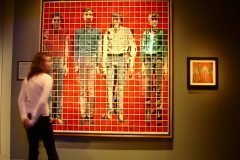Cleveland Rocks: The Rock and Roll Hall of Fame
 I think for anyone living outside of Ohio, Drew Carey’s contention that “Cleveland rocks” seemed a little tongue-in-cheek. And I still chuckle at the city’s name which reminds me of Spinal Tap getting lost backstage and shouting, “Hello, Cleveland!” So when I visited, I was surprised to find a vibrant city with a variety of quality entertainment, great restaurants and nightlife, and a collection of fine modern museums. But truly the crown jewel of it all for me was the Rock and Roll Hall of Fame.
I think for anyone living outside of Ohio, Drew Carey’s contention that “Cleveland rocks” seemed a little tongue-in-cheek. And I still chuckle at the city’s name which reminds me of Spinal Tap getting lost backstage and shouting, “Hello, Cleveland!” So when I visited, I was surprised to find a vibrant city with a variety of quality entertainment, great restaurants and nightlife, and a collection of fine modern museums. But truly the crown jewel of it all for me was the Rock and Roll Hall of Fame.
It’s hard for some of us to imagine actually losing consciousness at the performance of a rock star–without the use of any kind of mother’s little helper, that is. But though I can’t say there was any swooning, I did feel the jittery excitement of a kid on a magical mystery tour as I entered the hallowed hall. These were my idols, my icons, the creators of the soundtrack to my life. None of these people ever put their pants on more than one leg at a time, but let’s face it: they were and are often larger than life. So there is nothing more dissonant perhaps than standing before the classic Jim Morrison photo—shirtless, long-haired, Messiah-like legend—juxtaposed with his Cub Scout uniform and a school-age picture under glass.
 Like most visitors I was curious about how the inductees were chosen. (The Bee Gees?! Who let them in?) Performers become eligible 25 years after their first recording. Each year a committee selects nominees and an international body of over 1,000 “rock experts” votes on them, granting induction to those garnering more than 50% of the vote. This has led to some bickering and bewilderment at times. The formidable Kiss Army has marched on the museum in protest of the continued snubbing of their namesake, for example. The Hall of Fame Foundation was established in 1983 and began inducting members in 1986, but the museum didn’t open its doors until 1995. Designed by architect I.M. Pei, the building is a work of modern art bearing half a glass pyramid on the shores of Lake Erie. (Pei clearly has a pyramid fetish; he also did the controversial glass pyramid at the Louvre.)
Like most visitors I was curious about how the inductees were chosen. (The Bee Gees?! Who let them in?) Performers become eligible 25 years after their first recording. Each year a committee selects nominees and an international body of over 1,000 “rock experts” votes on them, granting induction to those garnering more than 50% of the vote. This has led to some bickering and bewilderment at times. The formidable Kiss Army has marched on the museum in protest of the continued snubbing of their namesake, for example. The Hall of Fame Foundation was established in 1983 and began inducting members in 1986, but the museum didn’t open its doors until 1995. Designed by architect I.M. Pei, the building is a work of modern art bearing half a glass pyramid on the shores of Lake Erie. (Pei clearly has a pyramid fetish; he also did the controversial glass pyramid at the Louvre.)
 With so many kitschy artifacts inside, this could have been nothing more than a glorified garage sale. But it’s not just a celebration of Beatles lunchboxes and Madonna’s underwear. This is serious social history as well. The exhibits trace the music back to its roots, and musicians such as Delta blues player Robert Johnson and jazz legend Louis Armstrong were inducted for their influence. A whole exhibit is dedicated to electric guitar pioneer (and Wisconsin native son) Les Paul. A hall of quotes and black and white wall-sized photography is a gloomy reminder of the extremism of self-righteous “moralists” who hated the music. Printed over a photo of Frank Zappa testifying passionately before Congress is this: “By God, rescue the tender young ears of this nation from this—this rock porn…” No, it wasn’t an example of a 1950s shocked parent hearing Elvis for the first time; this was US Senator Ernest Hollings in 1985 on the subject of censorship.
With so many kitschy artifacts inside, this could have been nothing more than a glorified garage sale. But it’s not just a celebration of Beatles lunchboxes and Madonna’s underwear. This is serious social history as well. The exhibits trace the music back to its roots, and musicians such as Delta blues player Robert Johnson and jazz legend Louis Armstrong were inducted for their influence. A whole exhibit is dedicated to electric guitar pioneer (and Wisconsin native son) Les Paul. A hall of quotes and black and white wall-sized photography is a gloomy reminder of the extremism of self-righteous “moralists” who hated the music. Printed over a photo of Frank Zappa testifying passionately before Congress is this: “By God, rescue the tender young ears of this nation from this—this rock porn…” No, it wasn’t an example of a 1950s shocked parent hearing Elvis for the first time; this was US Senator Ernest Hollings in 1985 on the subject of censorship.
The Hall of Fame also doesn’t ignore the broader picture of rock’s evolution. So much depended on an Ahmet Ertegun taking a chance on a young Ray Charles. Cleveland DJ Alan Freed, who first called the music rock and roll, was a preacher in his pulpit spreading a new gospel and has his own room here. Journalists, songwriters, backup musicians—many of the names may be unfamiliar; the museum brings these lesser sung heroes out of the shadows.
 There are somber moments as well: reminders of Marvin Gaye’s untimely death at the hands of his own father; a piece of Otis Redding’s plane wreckage, pulled from a lake not ten blocks from my home in Madison, Wisconsin; the story of starvation in Bangladesh and the performers who came to raise money and awareness.
There are somber moments as well: reminders of Marvin Gaye’s untimely death at the hands of his own father; a piece of Otis Redding’s plane wreckage, pulled from a lake not ten blocks from my home in Madison, Wisconsin; the story of starvation in Bangladesh and the performers who came to raise money and awareness.
Then in the theater I was riveted by three massive screens rolling out documentary footage. In the dark there I slipped into the past and started to feel what it must have been like when there was no classic rock yet, just the newest song on the radio and some new upstart icon wannabes swiveling their hips or banging their heads.
Of course, rock’s long strange trip hasn’t ended, and the On the Charts exhibit keeps things fresh with material from the latest rising stars. With such a breadth of material, the museum can become a personal experience. Some will be wowed by Roger Waters’ reconstruction of The Wall others will find fascination with Jimi Hendrix’s scrawled lyrics or a note from Hunter S. Thompson to his editor at Rolling Stone. How about the Sex Pistol’s handwritten (and misspelled) letter in response to being inducted in 2006: “Next to the Sex Pistols, rock and roll and that hall of fame is a piss stain. Your museum. Urine in wine. We’re not coming. Were [sic] not your monkey…” Inductee Bob Marley once sang, “If you know your history, then you would know where you coming from.” The Hall of Fame tells that tale and I am enthralled by it.
So does Cleveland rock? Yes, it does. I know it’s only rock and roll, but I like it.
Wanna Go?
 Rock and Roll Hall of Fame and Museum
Rock and Roll Hall of Fame and Museum
One Key Plaza, 751 Erieside Ave.
Cleveland, Ohio 44114
888-764-ROCK
Count on three to four hours minimum — or even more if you are a diehard fan. Two-day passes are available.
Open daily from 10 am to 5:30 pm with a late closing of 9 pm on Wednesdays. (Saturday’s hours extend to 9 pm as well from Memorial Day to Labor Day).
Admission: Adults US$22, Seniors/Military $17, Kids 9-12 $13, 8 & under FREE



 ORDER YOUR COPY TODAY!
ORDER YOUR COPY TODAY! ORDER YOUR COPY TODAY!
ORDER YOUR COPY TODAY!
Pingback: Six Great Rock’n’Roll Destinations